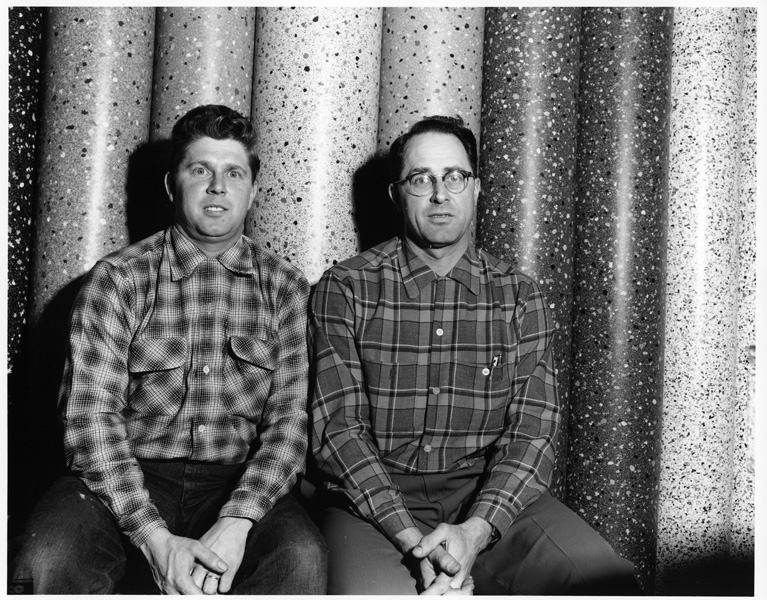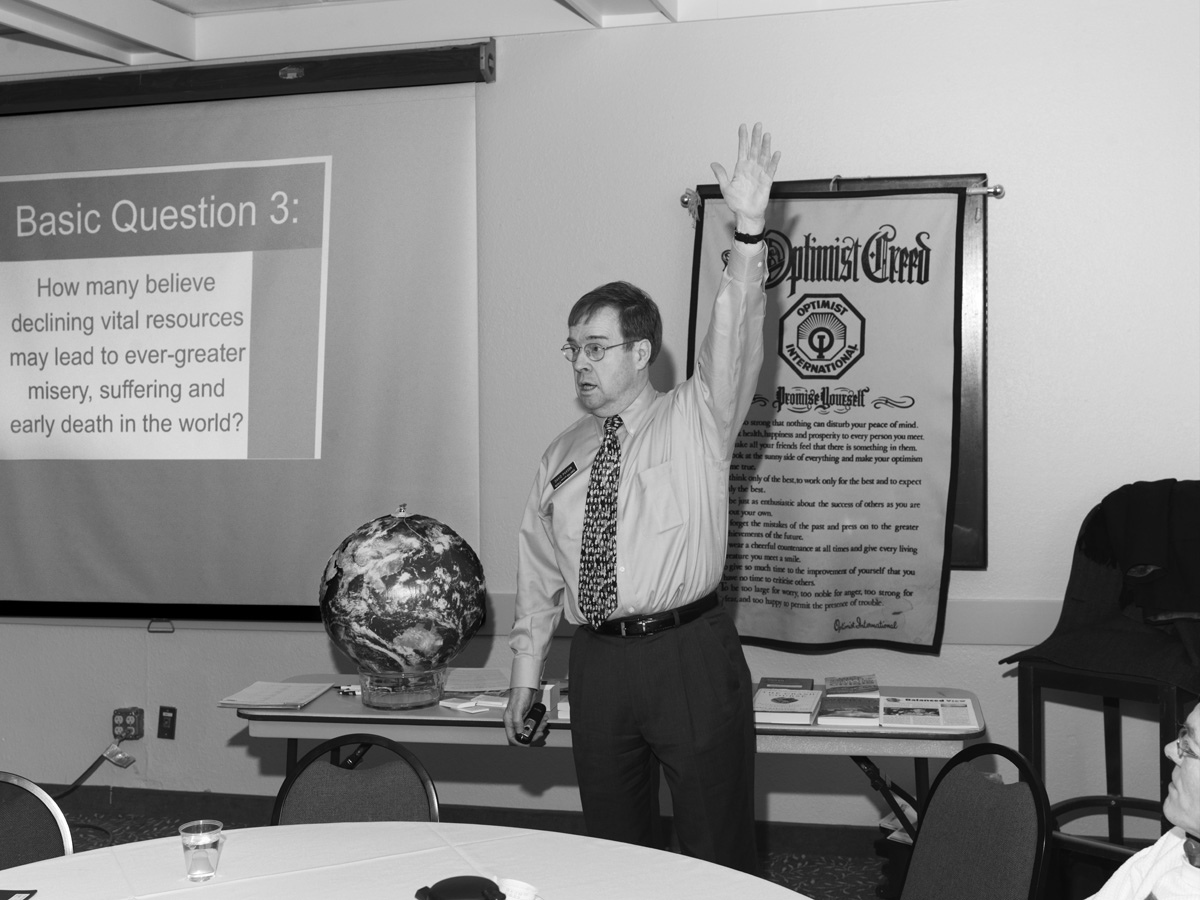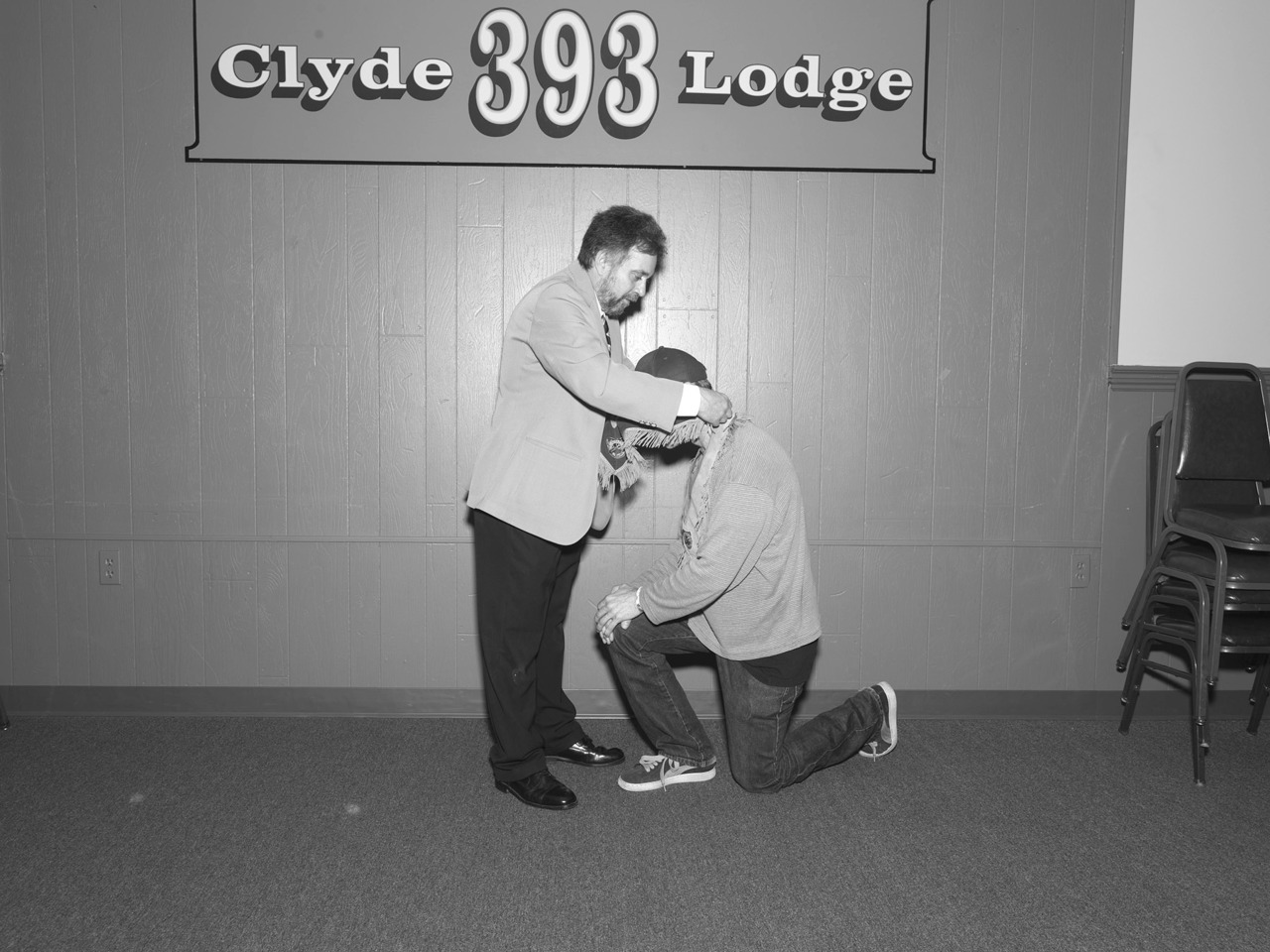Follow Alec Soth & Brad Zellar as they ramble around upstate New York from August 13-24 on The LBM Dispatch Tumblr page.
Pre-order LBM Dispatch #2: UPSTATE here
Follow Alec Soth & Brad Zellar as they ramble around upstate New York from August 13-24 on The LBM Dispatch Tumblr page.
Pre-order LBM Dispatch #2: UPSTATE here
The LBM Dispatch is an irregularly published newspaper of the North American ramblings of Brad Zellar and Alec Soth. Last May, from Ohio, we published the first dispatch.
We’re now happy to announce the new special edition, LBM Dispatch #1: OHIO.
Alec and Brad are currently on the road working on LBM Dispatch #2: UPSTATE. You can view their progress here. UPSTATE is also available for pre-order here.
Lastly, we’re announcing a subscription program for the LBM Dispatch. You can order three issues of the dispatch for the price of two here. We are also offering four issues of the special edition at a $500 discount here.
Thanks,
The LBM Management
Thanks to Tyler Stefanich and Mallory Heyer for whipping together the new website. We’re especially happy to have the blog and store under one roof. If you have any questions or bug reports, please contact: orders@littlebrownmushroom.com
Thank you,
The Management
I recently read a wonderful interview with Tobias Wolff from which I posted a couple of quotes on the LBM Tumblr. My favorite was this one:
We live by stories. It’s the principle by which we organize our experience and thus derive our sense of who we are. We’re in an unceasing flow of time and events and people, and to make sense of what goes past, we put a beginning and an end to a certain thing, and we leave things out and we heighten other things, and in that way we break the unbroken flow into stories, because that’s the only way we can give it significance.”
With that in mind, I want to tell a few stories about my friend Brad Zellar. 
Larry and Arnie Pahl, Bloomington Linoleum and Tile. 1956 by Irwin Norling
ONE) While hunting around in the basement of a suburban historical society, Brad discovered a treasure trove of photographs by someone named Irwin Norling. In a 2003 feature on Norling in City Pages, Brad wrote “I wasn’t more than a couple hundred photographs into the bottom drawer of the file cabinet and I knew that I was looking at an astonishing record of life in one American community. I spent much of the afternoon wading through those files, incredulous. What the hell was this? Who was this guy? And, a more pressing thought: What had I gotten myself into.” Five years later Brad published a book on Norling called Suburban World. This is my favorite story:
By the time the family moved into a new house in Bloomington in 1953 Irwin had a police radio that he never turned off. “I was going out to shoot photos at all hours of the day and night,” he remembered. “And all this time I was working eight hours at Honeywell, plus overtime.” As Norling’s pastime made greater demands on his time, it became a family affair. “When that police scanner went off, it didn’t matter what time of night it was,” Dave Norling said. “In a matter of minutes all of us were up and dressed and in the car.” There were occasions when the family would beat the police to an accident scene, which was, Pat said, considered somewhat bad form.
TWO) Up until that point I’d never met Brad, but I was asked to write an introduction to Suburban World wherein I told the following story:
My first job as a photographer was with a suburban newspaper on the eastern margin of the Twin Cities. Like most small-newspaper photographers, the job required me to be a generalist. I photographed baseball games and small-business owners, parades and potlucks. Most of my time was spent in the mushrooming suburb of Woodbury. Almost every week I had to attend a ribbon cutting for another new health club or minimall. I dreaded these assignments. The lineup always looked the same: a banker, a mayor, a pair of giant scissors (or a silver shovel), and a dozen other guys in in ties – an insult to my photographic artistry! Each year we submitted our best photographs for a national small-newspaper award. I would ransack my proof sheets looking for a gem, and I remember being particularly proud of a picture of a shilhouetted cross-country skier. But this photo, along with all of my other submissions, never even took third place. One year our elderly sports writer was driving home from a basketball game when he stumbled upon a peculiar automobile accident. Using his Kodak Instamatic, he snapped a picture of a car suspended in a tree. Though he didn’t know the first thing about F-stops and art history, the old guy managed to win the newspaper associations’s coveted award for spot news. The “real” photographers were sick with envy. That was when I leaned that most great pictures are not about artistry. If I’d been the one to photograph the car in the tree, I’d have won the award. The genius is not in technique; it is in being present.
THREE) Trolling online in 2010, I stumbled across some pictures that a Japanese traffic inspector had made while visiting the US in the early 70’s. I asked Brad Zellar if he wanted to investigate and/or invent the story behind the pictures. In the end, he created one of the most beautiful and mysterious book projects I’ve ever seen: Conductors of the Moving World: 
From Conductors of the Moving World by Brad Zellar
FOUR) In 2011 I asked Brad to investigate another character, the ever-reclusive Lester B. Morrison, for our book House of Coates. Brad dug up more information than I could have ever imagined about Lester. He was able to get access, I think, because Brad’s no stranger to the reclusive mindset. “I’ve had times where as a grown man I have run away. An eight-month stretch a couple of years ago in Vermont,” Brad told Minnesota Public Radio, “Just me and my dog.”
FIVE) On my last birthday, December 30th, I called Brad and asked him if he’d give me a gift. I was tired of the runaway fantasy and wanted to experience community life. I asked Brad if he’d join me on a newspaper story. We could be like Irwin Norling and his family, I said – I’d be the photographer; he’d be the reporter. Brad and I followed up on a story in the local paper about a cat that had been living for three months on a small patch of land between two interstates. On Christmas Day, the cat was rescued by a Woodbury policeman named Adam Sack. The Humane Society renamed the cat Adam in Sack’s honor and put him up for adoption. After photographing the notably skittish caged animal at the Humane Society, Brad and I drove out to the freeway interchange where Adam had been living. The small triangle of land happened to have both a deer carcass and a pipe with unfrozen water. It turns out Adam had been plucked out of Eden.
SIX) Brad and I started regularly going out on imaginary newspaper assignments. One day we attended a breakfast meeting of the Bloomington Optimist’s Club at the local Double Tree Hotel. After reciting the Pledge of Allegiance, the guest speaker was introduced. An expert in the perils of overpopulation, David Paxton gave the least optimistic presentation in the history of Powerpoint. “If you think driving a Prius is going to do anything good,” he barked at the small audience of mostly elderly Optimists, “well you’re just drinking the Cool-Aid.”  Guest speaker at the Bloomington Optimist Club by Alec Soth
Guest speaker at the Bloomington Optimist Club by Alec Soth
SEVEN) Last May, Brad and I made a road trip to Ohio. We didn’t find any Optimists, but we did visit a Moose Club in Clyde. We were there when they opened the doors at 6:30am. By the time they closed, Brad had been initiated into the club.  Brad becoming a Moose, from Ohio, by Brad Zellar & Alec Soth
Brad becoming a Moose, from Ohio, by Brad Zellar & Alec Soth
EIGHT) Brad recently wrote this on his blog, Your Man For Fun in Rapidan
I write every day, and have written every single day without exception for at least twenty years. My goal every night is 1000 words, and though that sometimes proves impossible, I have held myself to a strict 400-word minimum. Many nights I will write several thousand words. I have filled up hundreds of uniform, lined, black journals.”
NINE) My hope is to keep working with Brad for as long as I can. A week from today he and I are hitting the road to find some stories in upstate New York. Soon after we’ll publish another newspaper. In the meantime, you can read Brad’s stories on his blog or buy his books at the LBM store.
![]()

Breakfast, Trail’s End Restaurant, Kanab, Utah by Stephen Shore
I was recently reminded of last November’s post, ‘Should Artists Be Entertainers’ when I read about Nick Hornby’s new book ‘More Baths, Less Talking.’ This book is a compilation of Hornby’s ‘Stuff I’ve been Reading’ column in The Believer. I’m a huge fan of this column. Hornby doesn’t write formulaic book reviews. He talks about the real experience of reading. Over and over again this reading prompts Hornby to address the myriad ways in which we consume culture.
In one column, Horby discusses Carl Wilson’s book about Céline Dion, Let’s Talk About Love: A Journey to the End of Taste:
Why do I and my friends and all rock critics and everyone likely to be reading this book and magazines like the Believer hate Céline Dion?… We are cool people! We read Jonathan Franzen and we listen to Pavement, but we also love Mozart and Seinfeld! Hurrah for us! In a few short, devastating chapters, Wilson chops himself and all of us off at the knees. “It’s always other people following crowds, whereas my own taste reflects my specialness,” Wilson observes.
In a 2006 article in The Telegraph entitled ‘How To Read,’ Hornby talks about the need to embrace all forms of literature.
The regrettable thing about the culture war we still seem to be fighting is that it divides books into two camps, the trashy and the worthwhile. No one who is paid to talk about books for a living seems to be able to convey the message that this isn’t how it works, that ‘good’ books can provide every bit as much pleasure as ‘trashy’ ones.
Why worry about that if there’s no difference anyway? Because it gives you more choice. You may not have to read about conspiracies, or the romantic tribulations of thirty-something women, in order to be entertained.”
Yesterday my friend Ron Jude, wrote a comment after reading this quote in an in-flight magazine:
Originality is dangerous. If you want to increase the sum of what is possible for human beings to say, to know, to understand and therefore in the end, to be, you actually have to go to the edge and push outwards… This is the kind of art whose right to exist we must not only defend but celebrate. Art is not entertainment. At its very best, it’s a revolution.” —Salman Rushdie, in an address at Cooper Union, May 6, 2012
I’m all for celebrating revolutionary art, but this sort of work is, by definition, the extreme exception. A hundred thousand revolutions doesn’t do anybody any good.
As Ron mentions, the same in-flight magazine has a short interview with me about my favorite things in Minneapolis. The interviewer asked about my local dining habits. Knowing that countless people were going to read this interview, I wanted to say something really cool. But I’m not a foodie. I respect people who have a passion for fine cuisine, but it isn’t my thing. This doesn’t mean I eat at Burger King. I like good food, but I generally eat pretty simple food. In other words, I’m happy to know there are revolutionary French chefs working with liquid nitrogen, but I don’t necessarily need to eat it. And I most certainly don’t want to eat it every day.
So what do I want from my food? Along with it being nutritious, I’d like it to taste good. Isn’t entertainment in art pretty much the same thing?
On the website for The Sustainable Practice in the Arts, Robert Adams was asked, “What part does an artist play in society.” This was his answer:
First we have an obligation simply to be the citizens we want everyone to be – informed, engaged, reasonable, and compassionate. Then as artists we are called historically to a double mission, to instruct and delight, to tell the truth but also to find in it a basis for affirmation.
With this in mind, it is interesting to look at this year’s finalists for the prestigious Prix Pictet – a $100,000 award described as “the world’s leading prize in photography and sustainability.” When it comes to such vexing global problems, it seems extraordinarily difficult to fulfill Adams’ “double mission.”
Yesterday a friend of mine, Sarah Newman, sent me a link to her Kickstarter Project: Imaging Sustainability. Sarah’s plan is to photograph the sustainable urban landscape of Malmö, Sweden. She writes:
Here in the U.S., renewable energy is often kept outside of the energy-consuming cities – making energy production (and consumption) less visible in our landscape and in our consciousness. In Malmö, I will photograph green architecture and design, and people within the community, while conducting independent research on environmental and social sustainability.”
By showing us what the sustainable landscape might look like, Sarah is providing a valuable service. The challenge, I think, is to fulfill Adams’ double mission – to both instruct and delight.
I hope you’ll join me in supporting Sarah in this effort: IMAGING SUSTAINABILITY by Sarah W. Newman
![]()
Funny what photographers find on the street once they start looking. Robert Frank found latent disillusion; Gary Winnogrand found random social clarity; Phillip Lorce DeCorcia found the breadth and depth of exchange. Arianna Arcara and Luca Santese, two photographers from Italy, found photographs.
Not just one or two. Walking the streets of Detroit, Arcara and Santese found thousands of photographs. Found Photos in Detroit is a selection of this archive. There are mugshots, snapshots, interiors, police documentation, cars and notes varying in condition from unreadable abstraction to heartbreaking clarity. The only thing we know for sure about these photographs is the most important thing to know: they have all been abandoned. We don’t know who abandoned them: it could have been a family member or a bored janitor, it could have been the photographer or the subject of the photograph. All we know is that these photographs have come unmoored from the ties that bound them into a system of social meaning. They have been lost to the streets of Detroit, moving inexorably through various degradations toward a blank field of dissolution. It’s not a pretty picture. Maybe it never was.
 One more thing: Except for a single group portrait, every photographed person in Found Photos In Detroit is African American. Young and old, male and female, staring, glaring, entreating. The message is clear: It is Black culture, their houses, their rule of law, their very selves that have been abandoned. Like homeless ghosts, the social reality of these photographs haunts Detroit and America, signifying a despair so deep that abandonment is the only method left to represent their loss.
One more thing: Except for a single group portrait, every photographed person in Found Photos In Detroit is African American. Young and old, male and female, staring, glaring, entreating. The message is clear: It is Black culture, their houses, their rule of law, their very selves that have been abandoned. Like homeless ghosts, the social reality of these photographs haunts Detroit and America, signifying a despair so deep that abandonment is the only method left to represent their loss.
Within the form of the book, Arcara and Santese have constructed a shelter for these homeless images and, by extension, renewed meaning and social contact for their subjects. In the process, they have also created a powerful document of contemporary Detroit that moves beyond the bailout and the romanticized urban ruins of good times past to address the human tragedy that are the results of inequality, racism, and political impotence. That said, there’s no walking away from the fact that these images and their subjects tell another story. As so often in the past, these African-Americans have been reconstructed into a narrative not of their own making, revealing their utter representational powerlessness, no matter the intentions of the current powers that be. That is the agonizing contradiction at the heart of Found Photos in Detroit: that the source of its power as a social critique is made possible only by appropriating the despair of the abandoned. To hold those contradictory positions in your mind is to grasp the cost of representation; to hold them in your heart is to know truth as an oppressive other.
– Vince Leo
Reading Joerg Colberg’s reflections on the ten-year birthday of his blog made me consider the way in which blogging is like parenting. Both take a ton of time and energy and the rewards, while significant, are oblique. You also have to deal with a lot of tantrums.
My biggest frustration with blogging is the same as my frustration with parenting: not enough time. I’m particularly bothered that I’m unable to respond to the fantastic unsolicited books that people send us (if you follow our Tumblr page, you know we get a lot).
One of my favorite recent arrivals, for example, was Found Photos in Detroit by Arianna Arcara & Luca Santese. This book will surely end up on my list of favorite books from 2012, but it deserves more critical attention than just being on another list.
So I turned to one of the best arts writers I know, Vince Leo, and asked for help. Vince just sent me his review and I couldn’t be happier. His text has me thinking about the book, and myself, in an entirely new way.
One of the lessons of parenting is that you need to ask for help. While you may not be able to hire a nanny, it’s essential to splurge on a babysitter now and then. I’m beginning to think the same is true for raising a healthy blog.
– Alec Soth
If you enjoyed Carrie Elizabeth Thompson’s recent post on being an artist and a mother (here), you might enjoy following Carrie’s Tumblr. For over a month, Carrie has taken on the ambitious task of posting 10 pictures a day of her life as an artist/mother. For those of us who struggle to be alert to the beauty, mystery and complexity of everyday life, Carrie’s blog is an eye opener. Go here: http://carrielizabethompson.tumblr.com/
![]()
no images were found
From May 17-24, Brad Zellar and I visited a dozen towns and cities throughout Ohio in search of community life. We went to soup kitchens and McDonalds, proms and churches, golf courses and cemeteries. Along the way we recorded the faces and voices of people longing to connect with their neighbors. We made some powerful connections too (Brad became a member of the Loyal Order of the Moose). To commemorate this remarkable trip, we’ve produced a newspaper a mere week after our return.Buy it here: https://littlebrownmushroom.com
![]()